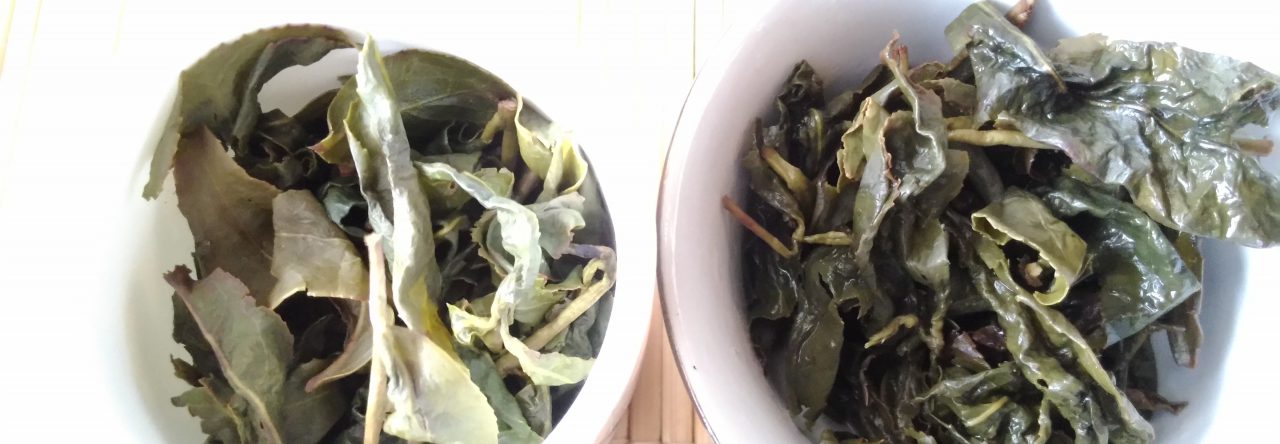Gu Shu 古樹 is a general term for ancient aging tea trees that are older than hundreds to thousand of year old, that normally grow in nature forest and are found on the high altitude areas. It is hard to say precisely how old these tea trees are because these trees are under protection; so people can only give an estimation based on its height and size. In Yunnan, it has already discovered more than 1,000 acres of ancient tea trees; there are 14 estates are connected together, the cover area is about 21.21 acres. Till now the countable discovered thousands year old ancient tea trees in Yunnan are 32 trees, it is about 43% from what have been discovered in China.
Gu Shu Pu-erh tea comprises in two different categories:
- Transitional cultivated type : Tea trees have been cultivated long long time ago, from few hundreds to thousands of year; basically the size of tea tree is tall and strong.
- Ye Sheng 野生, it short means wild tea trees that were found in between nature forest and cultivated tea plantation and its DNA is related to the cultivated tea trees. Not all wild tea trees can be processed to make tea drink because many raw tea leaves are pretty bitter. Good quality is limited.
But Ye Shen Cha (野生茶 Pu-erh tea made from wild tea trees ) is not equivalent to Gu Shu Cha (古樹茶 Pu-erh tea made from Ancient aging tea trees), Da Shu Cha (大樹茶 Pu-erh tea made from transitional aging tea trees) or Shen Tai Ye Fang Cha (生態野放茶 Pu-erh tea made from widely cultivated aging tea trees) . Ye Shen Cha is not necessary equivalent to good quality tea.
- Arbor type of tea trees that are divided by the age :
- if the age of the arbor type of tea tree is younger than 100 years old, it’s called Old Tea Tree (老樹),
- the age is between 100-300 as Big Tea Tree (大樹),
- if it’s older than 300 years, then it is called Gu Shu (古樹)
- The ancient cultivated arbor type of Gu Shu (栽培型古樹) , the age is more than 300 years ago and grow in a natural protected environment can produce good quality Pu-erh tea.
- Shen Tai Ye Fang (生態野放) means these tea trees that were manually cultivated but have been abandoned for decades or few hundreds of year, the plantation is now under well organic management.
- Ye Shen Cha (野生茶 Wild tea tree cultivar) means those tea trees that have been grown widely without being cultivated or management. Tea trees were grown from seeds, there are lots of variety. No hair or very little hair on the young buds/leaves, the edge has less cog or none; the color of fresh raw tea leaves is in dark olive green color. There are lots of cultivars in wild tea trees, no much can be processed to make tea because of its bitter taste, the local aboriginals call it as Ku Cha (苦茶). The wild tea contents more soap base and have mild toxic micro, can cause diarrhea. It is advised to be cautious with the consumption of this kind of Ku Cha.
When we enjoy and try to promote Pu-erh tea, it is important to establish some basic understanding before creating more confusions:
- “Aged Pu-erh” 陳年普洱 means Pu-erh tea made from either Lao Shu (老樹) or Da Shu (大樹) or even from Ping Di (平地) that’ve been stored for long time, it can be either loose leaves, tea brick or tea cake. Can you distinguish the change of aroma and taste during the transformation? It is a surprising life-time learning.
- Gu Shu Pu-erh” 古樹普洱 means Pu-erh tea that madefrom ancient tea trees, either from transitional cultivated tea tree or Ye Shen (Wild) tea tree cultivars. Since the growing areas of Gu Shu are spreading in pretty wide region in Yunnan, therefore, it is necessary to find out more behind the name.
- Basic thing you need to check is:Is it a raw or ripped Pu-erh? The color, aroma and taste will reveal the truth once you have a chance to physically check on it and brew it; the change of transformation is a amazing surprisePrecise information about the growing region
- Is it from Ping Di (平地 lower altitude) or Gao Shan (高山 high altitude above 1000m)
- The quality of leaves, i.e. the single source of tea leaves or blended leaves; is it tou cha, tea cake, tea brick or loose leaves
- In which year it was being truly made, the condition of the wrapping paper and in-fly can reveal a lot of information already.
Like for all kind of tea, there is no better method to evaluate the tea besides checking the quality by its look (shape & color), aroma, flavor and taste.
Tea is a wonderful gift from Nature; it is a simple agricultural product but its complexity is much deeper and wider that no one can really draw the end line for exploration and learning. The journey of tea begins from liking and appreciating tea. Tea is a great teacher when we are willing to explore further with a opened mind and maintain a curious learning attitude. The name or the brand is not necessary mean good quality tea, because each person might have her/his unique preferences to flavor and taste, basically what that person likes and can afford are ‘good’ tea to that person.
What is your favorite tea today? Enjoy a peaceful tea moment.




Leave a Reply
You must be logged in to post a comment.